Filipino student’s lamb-dish creation wins gold at Hong Kong culinary tilt
Michael Cheng of CCA-Manila bested other entries from Taiwan, Mongolia and Canada
By Vangie Baga-Reyes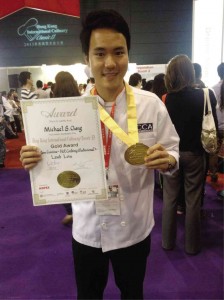
MICHAEL Cheng shows off his gold medal and certificate
in the Western Cuisine Professional Lamb Loin category.
He failed to drizzle the lemon chantilly onto the lamb because he only had a minute to plate the dish before a group of foreign judges.
That’s how Michael Cheng, 28, knew that he blew his chance of winning the top prize at the Western Cuisine Professional Lamb Loin category at the Hong Kong International Culinary Classic 2013 (Hofex edition) held last week in Wan Chai, Hong Kong, the region’s leading food and hospitality trade show.
The sour hint of lemon chantilly, a blend of limoncello and whipped cream, was supposed to cut or balance the savory-bitter taste of the meat.
Knowing everything was lost, Cheng, a Center for Culinary Arts-Manila student, just went back to his hotel and felt sorry for himself.
Little did he know that with or without the acid component, the international judges were impressed with Cheng’s stirring play of flavors in the dish and the way he plated it.
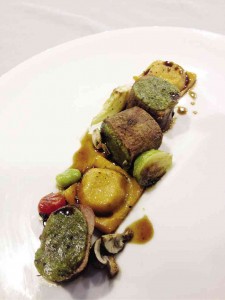
THE WINNING dish: Pistachio Pesto Cap Sous-Vide Lamb
Medallion, Rioja-Glace de Viande, Lemon Chantilly, Caramelized Butternut Squash
Ravioli, Cherry Tomato and Lima Bean Confit, Champignon and Pearl Onion
Preserved
Cheng presented Pistachio Pesto Cap Sous-Vide Lamb Medallion, Rioja-Glace de Viande, Lemon Chantilly, Caramelized Butternut Squash Ravioli, Cherry Tomato and Lima Bean Confit, Champignon and Pearl Onion Preserved.
Cheng also stunned the judges with the many cooking techniques he employed in a single dish—sous vide, confit, grilled, pan-seared, sautéed, preserved, reduced and blanched.
This got the approval of the judges, who awarded him the gold.
“I jumped for joy when I saw the gold card beside my display plate,” said the ecstatic Cheng, who started practicing for the competition in February. This was his first time to win in an international competition. In Manila, he won silver for his Modern Pinoy dish at Kumbira 2011.
This was also the first for CCA-Manila to win gold in a foreign culinary tilt.
“Initially, I didn’t want to check the scoreboard. I told my teammate John Angeles that I would cry if I didn’t see my name,” said Cheng. So it was Angeles who first went to the display table and started jumping and shouting, “gold!”
Done in 60 minutes
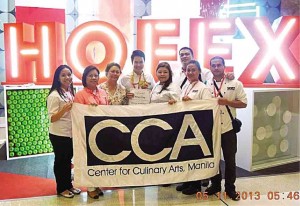
CCA-MANILA family: Renee Marie Usares; Badjie
Guerrero-Trinidad, CEO of Cravings group; Annie Guerrero, president of Cravings
Group; Michael Cheng, gold medalist; head coach chef Mira Cruz; John Vincent
Angeles; Sandlylin Mortel; Ronald Ico
Cheng bested other entries from Taiwan, Mongolia and Canada.
Entries were judged according to correct professional presentation, arrangement, taste, mise-en-place and cleanliness. The competitors were to prepare three portions of one-plated main course within 60 minutes. Each was given a 500-g lamb loin fillet as the main ingredient. The accompaniments and garnishes to complement the dish were the competitor’s choice.
The taste was the crucial criterion. It must have appropriate seasoning. In quality, flavor and color, the dish must conform to today’s standards of nutritional values.
Cheng and other participants were provided a working station with facilities, such as four-stove induction cooking range, electric oven, working tabletop, sink with running water, fridge, deep fat fryer and salamander.
However, in any live competition, some things suddenly don’t work your way. Apart from the lemon incident due to time constraints, Cheng almost burned the butter for his lamb sauce because he was busy cutting, mixing and plating.
“I only had about two minutes to wrap things up,” he recalled. “When we were practicing in Manila, we would put the sauce first on the plate. What I did in HK, I started plating first and forgot about the butter in the saucepan. Luckily, the burnt taste blended well with the meat and other ingredients in the plate.”
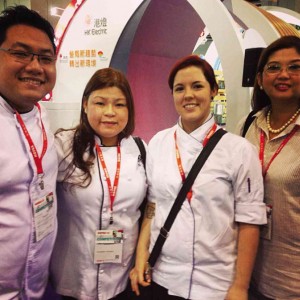
TEAM supporters: chef RJ Ungco, chef Mira Cruz, a
female student from Northern Alberta Institute of Technology in Canada (CCA
partner school) and CCA PR manager Anne Certeza- Palmares
CCA team head coach and chef-instructor Mira Cruz, however, thought that if the judges tasted the sauce alone it would be a different story.
“The judges wouldn’t distinguish the burnt taste because the particular wine we used for the reduction was already bitter,” said Cruz, who was assisted in the team by chef-instructor RJ Ungco. “I doubt if they would taste the sauce alone. In this category, they would often eat the food altogether.”
More challenges
Last year, Cheng was one of the top students of CCA-Manila, which sent him to Korea as international exchange student. Cheng was a scholar of culinary arts at the Woosong University in Daejeon, South Korea. He applied for the scholarship and passed with flying colors.
He studied Global Korean Culinary Arts for nine months, with a three-month apprenticeship. He learned Korean Royal cuisine, Palace cuisine, how to make kimchi, rice cake and side dishes, among other things.
On competition day, Cheng was surprised to see that his main ingredient, the lamb, still had its litid (or silver skin or ligaments). In most cases, the litid is taken out from the meat. It’s very tough and often removed with a sharp knife to prevent the meat from curling during cooking.
But Cheng was able to put into practice his training from Korea.
“Prior to competition, the lamb fillet we would buy from Santi’s had no more ligaments,” said Cheng. “When the lamb was handed to me on competition day, it had ligaments. Luckily, I was trained in Korea to remove the silver skin of tenderloin and other parts of the meat.”
Cheng successfully got rid of the silver skin, but since it was not part of his action plan, it ate up much of his time and made him miss the lemon component in the last part.
Also, “In Manila, we would practice with a low-fire stove. In HK, there was no fire. We would just adjust the heat from the induction stove,” said Cheng.
Triumphant
Despite the glitches and mishaps along the way, the CCA team was jubilant with the honor they brought home not only to their school, but also to the country.
One of the judges, chef Alan Orreal, executive chef for Resorts World Sentosa-Singapore, was quoted telling Cheng: “I really like the fact that you created a pasta and you stuffed it nicely. You also showed us different sets of skill. The flavor balance is really good. The seasoning is well-balanced and really quite good.”
His only comment on Cheng’s dish: “I would never cut my lamb in an almost straight section. Instead, cut it in cross-section. But, never cover up the cross-section with some pesto. I would put that more on the side so I could really showcase the product. But, overall, the skill, flavor and plating are very good. So well done.”
Cheng was the only one in the group who did sous vide. Sous vide is a French word for “under vacuum.” It’s a food-packaging technique to keep the meat extra-tender, pink and juicy.
The group brought their own sous vide machine and vacuum.
“The night before Mike competed, we again doodled and drew on the plate what and how we wanted the dish and plate to be presented,” said Cruz. “I was so tense with Mike. He was so anxious to win until we told him last-minute to follow his instincts. Whatever his heart tells him to do, just do it. It’s his call and it’s his day.”
Cruz added: “That’s what happened. We are all happy everything went well. It’s a team effort. I told them, win or lose, we should learn something from the experience. To be able to finish everything on time is already an achievement. Many in Mike’s category were not able to finish on time.”
Moral support
Cheng, who is also a registered nurse, credits his victory to his teammates, coaches and CCA school family for the all-out support.
“I thank all of them for the words of encouragement and for teaching us to go beyond our imagination and pushing us to our limits. I hope that the school will continue to support the future competing team because this is really a good opportunity for us students and chefs to hone our skills and develop discipline,” said Cheng, whose parents are both Chinese from Fujian province.
“This victory is more meaningful for CCA,” added Cruz. “Not only because of the time and hard work that we as a team invested, but because despite such a difficult period in our life (one of her good friend, co-faculty and informal coach to the students, Jon Tin, passed away five days before the competition), we still managed to give our best through teamwork and a positive team spirit.
“This gives us pride to say that we can be at par or even better than other countries. Having experienced defeat when I was a competitor myself, I hope that I was able to instill in the team a never-say-die attitude, executed in such a positive and cheerful manner in the most trying times.”
Annie Guerrero, president of Cravings Group of Companies (CGC), and Badjie Guerrero-Trinidad, chief executive officer of CGC, also flew to Hong Kong to give the team moral support.
“We warmly congratulate Michael, as well as the two coaches Mira and RJ, for bringing honor to CCA,” said Trinidad. “We’ve always supported our students to join international competitions to give them the edge, motivation, exposure and opportunities to be the global chefs that the school have always envisioned them to be.”
She added: “I have observed Michael up close when we visited him as an exchange student in Korea. I was impressed with his professional and gentle demeanor, serious and focused in his studies. We are proud of the team who all did their best to represent CCA in a tough competition among professionals.”
Other competing members of CCA in HK were Sandlylin Mortel for Modern Chinese Cuisine Challenge Hot Cooking (Creative Appetizer); Ronald Ico for Modern Chinese Cuisine Challenge Hot Cooking (Creative Appetizer); John Vincent Angeles for Western Cuisine-Professional: Sustainable Fish-Atlantic Cod; and Renee Marie Usares for Pastry-U25 Apprentice: Young Pastry Chefs Chocolate Fragrant Tea Cake (Student Session). Also seen giving encouragement to the team was Anne Certeza-Palmares, CCA corporate public relations manager.
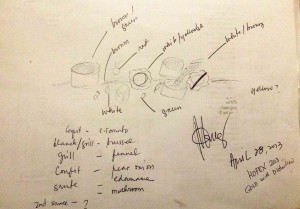
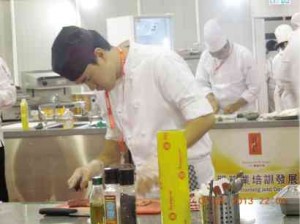

No comments:
Post a Comment